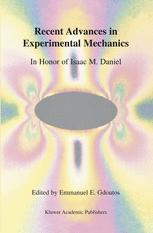

Most ebook files are in PDF format, so you can easily read them using various software such as Foxit Reader or directly on the Google Chrome browser.
Some ebook files are released by publishers in other formats such as .awz, .mobi, .epub, .fb2, etc. You may need to install specific software to read these formats on mobile/PC, such as Calibre.
Please read the tutorial at this link: https://ebookbell.com/faq
We offer FREE conversion to the popular formats you request; however, this may take some time. Therefore, right after payment, please email us, and we will try to provide the service as quickly as possible.
For some exceptional file formats or broken links (if any), please refrain from opening any disputes. Instead, email us first, and we will try to assist within a maximum of 6 hours.
EbookBell Team

0.0
0 reviewsThis book contains 71 papers presented at the symposium on “Recent Advances in Experimental Mechanics” which was organized in honor of Professor Isaac M. Daniel. The symposium took place at Virginia Polytechnic Institute and State University on th June 23-28, 2002, in conjunction with the 14 US National Congress of Applied Mechanics. The book is a tribute to Isaac Daniel, a pioneer of experimental mechanics and composite materials, in recognition of his continuous, original, diversified and outstanding contributions for half a century. The book consists of invited papers written by leading experts in the field. It contains original contributions concerning the latest developments in experimental mechanics. It covers a wide range of subjects, including optical methods of stress analysis (photoelasticity, moiré, etc.), composite materials, sandwich construction, fracture mechanics, fatigue and damage, nondestructive evaluation, dynamic problems, fiber optic sensors, speckle metrology, digital image processing, nanotechnology, neutron diffraction and synchrotron radiation methods. The papers are arranged in the following nine sections: Mechanical characterization of material behavior, composite materials, fracture and fatigue, optical methods, n- destructive evaluation, neutron diffraction and synchrotron radiation methods, hybrid methods, composite structures, and structural testing and analysis.